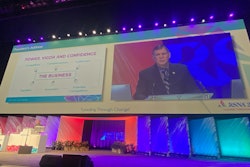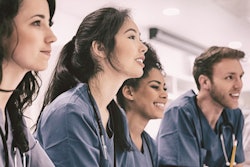CHICAGO -- Among the imaging informatics sessions at RSNA 2023 are innovations designed to reduce the barriers of running AI algorithms in everyday radiology. To that end, research at the University of Pennsylvania suggests starting with an AI server.
“For radiologists, we need AI to be fast … unobtrusive … and verifiable. We want AI results ready by the time we open a study,” explained presenter Neil Chatterjee, MD, PhD. “From the IT or enterprise point of view, we want AI that is secure,” he said, emphasizing fast outputs, smooth integration, and adhering to standards such as DICOM and HL7.
 Neil Chatterjee, MD, PhD.
Neil Chatterjee, MD, PhD.
“There is quite a big gap between the amount of AI we see everywhere around us and the relatively small amount we use day to day,” he noted. “We think part of that is because it can be difficult to find AI that meets the needs both of the radiologists that use it every day and the needs of the larger IT enterprise.”
In search of a win-win for AI in everyday use in radiology, Chatterjee and colleagues chose to narrow their proof-of-concept study to CT. He explained that with completed imaging an HL7 message is sent to the vendor neutral archive which triggers the PACS to send appropriate imaging data to the AI server that then treats the imaging studies with selected algorithms.
Downstream of PACS, the AI server exports quality control images back to the PACs for radiologists' review as well as sends AI results to the reporting engine, Chatterjee explained. The Penn study tested using an HL7 router to make API calls to insert AI results into custom fields in the radiology report.
The AI server lives behind the organization’s VPN on a private connection, and no data is transferred over the public internet, Chatterjee said. He estimated server cost to be about $450 a month for a large hospital with multiple sites. For scalability, the cloud-based system can accommodate more processing and storage.
As a test case, Chatterjee’s team implemented opportunistic hepatic steatosis screening on noncontrast abdominal CT scan performed across their organization. Over 60 days, the AI server processed just over 1,000 noncontrast abdominal CTs across three different sites using different scanners.
The average turnaround time -- from the start of data transfer to the AI server to complete AI analysis and all results back into the PACS and into the reporting engine -- was slightly less than three minutes. The added opportunity for imaging analysis was fully integrated into normal workflow, with no extra windows or clicks to navigate, Chatterjee said.
“Outside of truly emergent cases like stroke or trauma, the vast majority of the time, AI results are going to be ready for the radiologist by the time they open the study,” Chatterjee said.
In cases where liver or spleen attenuation may be required, for example, those measurements can be included in the report either by using a macro, or the measurements can be part of the default reporting template. In either case, all the values are already filled in, Chatterjee said, and there is no extra work for the radiologist.
“Our orchestrator is constantly listening for new DICOM images. For example, for noncontrast abdominal CT you might segment the liver and spleen and calculate mean attenuation to opportunistically screen for hepatic steatosis. We'll send the organ segmentations to the PACs for radiologists' quality control. Then from the values we calculate, we'll generate common data elements and export those in the form of a DICOM structured report that goes to the reporting engine. We can repeat this process for any other algorithms we might want to run.”
The next step is to work toward adoption, funneling more imaging through the AI server and adding more AI algorithm analysis. Over time, Chatterjee said they will continue to optimize the algorithms already available, as well as reduce turnaround time and decrease server costs. In addition, the private AI server will build a foundation for big data research.
“So you can take this infrastructure that I laid out before, and you can imagine another pipeline going from the AI server to a research database, so that every time we're processing AI for our clinicians, not only are the radiologists getting that information, but we're passively accumulating all these AI results into a research database, and we can start answering research questions with thousands, tens of thousands, hundreds of thousands of studies,” he concluded.




















